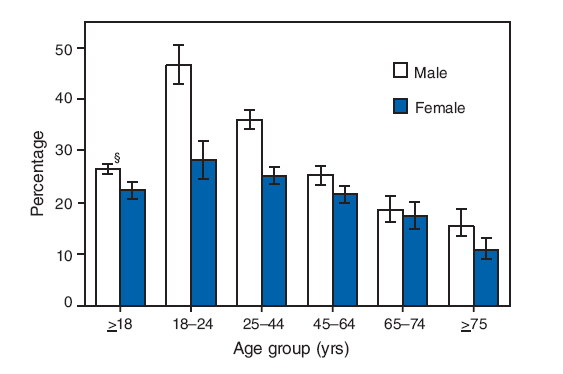Persons using assistive technology might not be able to fully access information in this file. For assistance, please send e-mail to: mmwrq@cdc.gov. Type 508 Accommodation and the title of the report in the subject line of e-mail.
QuickStats: Percentage of Adults Aged ≥18 Years Who Engaged in Leisure-Time Strengthening Activities,* by Age Group and Sex --- National Health Interview Survey, United States, 2008†
Please note: An erratum has been published for this article. To view the erratum, please click here.

* Based on responses to the following question: "How often do you do leisure-time physical activities specifically designed to strengthen your muscles, such as lifting weights or doing calisthenics?"
† Estimates are based on household interviews of a sample of the civilian, noninstitutionalized U.S. population.
§ 95% confidence interval.
In 2008, approximately 27% of adults participated in leisure-time strengthening activities, an important component of overall physical fitness. Among all age groups except those aged 65--74 years, men were more likely than women to engage in leisure-time strengthening activities. The percentage of men who engaged in leisure-time strengthening activities decreased with age, from 47% at age 18--24 years to 16% at age ≥75 years. The percentage of women who engaged in leisure-time strengthening activities decreased with age, from 28% at age 18--24 years to 11% at age ≥75 years.
SOURCE: Unpublished estimates from the 2008 National Health Interview Survey. Available at http://www.cdc.gov/nchs/nhis.htm.
Alternative Text: The figure above shows the percentage of adults aged ≤18 years who engaged in leisure-time strengthening activities, by age group and sex, according to the the National Health Interview Survey in 2008. Approximately 27% of adults participated in leisure-time strengthening activities, an important component of overall physical fitness. Among all age groups except those aged 65-74 years, men were more likely than women to engage in leisure-time strengthening activities. The percentage of men who engaged in leisure-time strengthening activities decreased with age from 47% at age 18-24 years to 16% at age ≤75 years. The percentage of women who engaged in leisure-time strengthening activities decreased with age from 28% at age 18-24 years to 11% at age ≤75 years.
Use of trade names and commercial sources is for identification only and does not imply endorsement by the U.S. Department of
Health and Human Services. |
All MMWR HTML versions of articles are electronic conversions from typeset documents. This conversion might result in character translation or format errors in the HTML version. Users are referred to the electronic PDF version (http://www.cdc.gov/mmwr) and/or the original MMWR paper copy for printable versions of official text, figures, and tables. An original paper copy of this issue can be obtained from the Superintendent of Documents, U.S. Government Printing Office (GPO), Washington, DC 20402-9371; telephone: (202) 512-1800. Contact GPO for current prices.
**Questions or messages regarding errors in formatting should be addressed to mmwrq@cdc.gov.Date last reviewed: 9/3/2009


